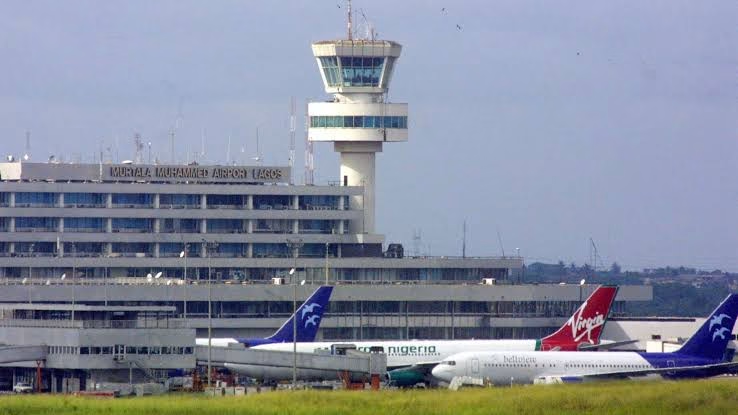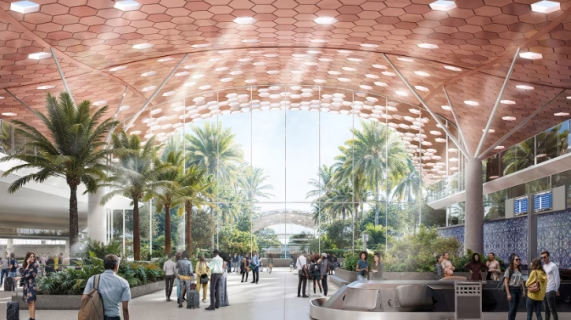Africa’s aviation sector is entering a transformative era, with billions of dollars being invested in new airports and major expansion projects across the continent. Driven by rapid urbanization, rising passenger demand, and the push to strengthen regional and global connectivity, many African countries are modernizing their existing facilities while also building entirely new airports designed to rival international hubs. From mega-projects like Ethiopia’s upcoming Bishoftu International Airport to strategic upgrades in Nigeria, Morocco, and South Africa, these developments highlight the continent’s ambition to position aviation as a catalyst for trade, tourism, and economic growth.
1. Ethiopia – New Mega-Airport near Addis Ababa
The Bishoftu International Airport project in Ethiopia is set to become Africa’s largest aviation hub, with construction expected to conclude in 2029. Located about 45 kilometers from Addis Ababa, the airport will feature four runways, parking for 270 aircraft, and capacity to handle 100 million passengers annually. Phase 1 alone will cost at least US$6 billion, financed primarily through loans, with strong interest already expressed by international firms. The new airport will complement Addis Ababa’s Bole International Airport, which is nearing its maximum capacity of 25 million passengers per year.
The project has faced delays since first being announced in 2018, with multiple rounds of requests for proposals receiving limited responses. However, renewed momentum has been achieved with the appointment of China Civil Engineering Construction Corporation (CCECC) as a key participant and Dubai-based Sidara leading the design. Additional contributions from Dar Al-Handasah Consultants, Zaha Hadid Architects, and other global experts underscore its international scope.
Built on 35 square kilometers of land at a lower elevation near Bishoftu, the airport is expected to improve fuel efficiency and support longer-distance flights. Beyond easing congestion, it will position Ethiopia—and East Africa more broadly—as a central hub for global air travel, reinforcing Ethiopian Airlines’ leading role on the continent.
2. Kenya – A new Greenfield Airport
Kenya’s government has unveiled plans to construct a new airport that will replace the existing Jomo Kenyatta International Airport (JKIA) in Nairobi. The announcement was made by Transport Cabinet Secretary Davis Chirchir during the Public-Private Partnership (PPP) Symposium in Nairobi. Chirchir emphasized that the project is intended to overcome long-standing infrastructural challenges at JKIA, which has struggled to meet growing demand since a major fire incident in 2013. He described the new airport as a state-of-the-art facility that will act as an anchor project, positioning Kenya as a leading aviation hub in the region.
The government intends to implement the project through Public-Private Partnerships (PPPs) to ensure financing and timely completion. This follows setbacks such as the cancellation of the Adani Group deal in November 2024 over corruption concerns. President William Ruto has since directed that PPP discussions be restructured to ensure transparency.
3. Rwanda – Bugesera International Airport
Rwanda is advancing the New Bugesera International Airport (NBIA), a $2 billion project aimed at positioning the country as a major aviation hub in Africa. Initially launched in 2017, the project is being developed in two phases. Phase 1, expected to be completed in 2027, will give the airport the capacity to handle up to 7–8 million passengers annually, while Phase 2, scheduled for 2032, will expand capacity to 14 million passengers per year.
Located 40 kilometers from Kigali, NBIA will feature a 3,750-meter runway, with additional runways planned in later phases. The design also includes a modern passenger terminal, a presidential terminal, cargo facilities capable of handling 150,000 tons annually, and advanced aircraft maintenance and catering services. Supporting infrastructure such as a 14 km expressway linking the airport to Kigali will also be constructed. Importantly, the project integrates green building concepts to enhance sustainability.
The Rwandan government recently allocated Rwf699 billion ($499 million) in the 2025/26 budget toward the airport, while also seeking external financing, including a $200 million loan from the Asian Infrastructure Investment Bank. Development is being undertaken in partnership with Qatar Airways, which holds a 60% stake in the project and plans to expand its African network, further reinforcing Kigali as a strategic regional hub by 2028.
4. Somalia – Haawaay Airport Project
Somalia has launched the Haawaay Airport Project, a landmark development that will deliver a new international airport within the next five years. President Hassan Sheikh Mohamud announced the project, emphasizing that modern infrastructure is key to reviving Somalia’s economy and supporting long-term growth.
The $800 million facility, officially named the New Mogadishu International Airport, will be located in Haawaay (Warsheekh district), Middle Shabelle region. Groundbreaking took place on June 29, 2025, with completion expected by 2030. The new airport aims to ease congestion at Aden Adde International Airport in Mogadishu and improve Somalia’s connectivity, positioning the capital as a strategic hub in East Africa.
5. Nigeria – Murtala Muhammed International Airport (MMIA)
Nigeria’s Federal Government has launched a $500 million upgrade of Murtala Muhammed International Airport (MMIA) in Lagos, its busiest airport handling 67% of national air passengers. The project, funded entirely through the Renewed Hope Infrastructure Development Fund, is being executed by China Civil Engineering Construction Corporation (CCECC) and will be completed in 22 months.
The upgrade includes a complete overhaul of Terminal 1, built in 1979, which will be stripped down to its frame and rebuilt with modern systems and finishes. Terminal 2 will be expanded, along with the apron, to accommodate wide-body aircraft. Key infrastructure improvements include two new independent ring roads, a new bridge for direct departures access, a Skywalk linking the car park to Terminal 2, and a connection building between the two terminals.
Additional works involve new smart airport solutions, upgraded airfield lighting, enhanced security fencing with surveillance systems, and redesigned landscapes. The project aims to transform MMIA into a world-class facility and solidify Lagos as a premier West African aviation hub.
6. Nigeria – New terminal at Samuel Ladoke Akintola Airport
The Oyo State Government has launched the construction of a new terminal at Samuel Ladoke Akintola Airport, Ibadan, marking a major step in transforming the facility into a regional aviation hub. Governor ‘Seyi Makinde officially laid the foundation for the project, which will be executed by Craneburg Construction Ltd and completed by 2026. The terminal is designed to handle one million passengers annually, significantly boosting Ibadan’s air transport capacity.
This development follows the first phase of upgrades begun in September 2024, which included extending the runway to 3,000 meters to meet international standards. The new terminal will further enhance passenger experience, cargo handling, and overall connectivity.
7. Morocco – Mohammed V International Airport
Morocco has launched a $1.6 billion expansion project at Mohammed V International Airport in Casablanca, the country’s largest aviation hub. The Office National des Aéroports (ONDA) has awarded a $29 million enabling works contract to Société des Travaux Agricoles Marocaines (STAM), marking the start of preparatory construction. These initial works will pave the way for the main terminal expansion, with tenders for the full development currently in progress.
The ambitious project aims for completion by 2029, aligning with Morocco’s preparations for the 2030 FIFA World Cup. Once finalized, the upgraded airport will accommodate up to 30 million passengers annually, significantly enhancing capacity and service quality. The expansion is expected to strengthen Casablanca’s role as a major international aviation hub, boosting Morocco’s connectivity, tourism, and trade. By modernizing facilities and scaling up passenger handling, the project positions the airport to meet growing regional and global air travel demand.
8. Morocco – Marrakech-Menara and Agadir-Al Massira airports
Morocco’s National Airports Authority (ONDA) has awarded contracts valued at approximately MAD 4.4 billion (around $440 million) to expand both Marrakech-Menara and Agadir-Al Massira airports. Jet Contractors received the Marrakech project (MAD 2.2 billion), which will enlarge the terminal to roughly 142,000 m² and raise annual capacity from 9 million to 16 million passengers. Meanwhile, SGTM was awarded the Agadir expansion, also for MAD 2.2 billion. Their plan will increase the terminal to 75,000 m²—combining renovation and new construction—to boost capacity from 3 million to 7 million passengers. These upgrades form part of ONDA’s broader Airports 2030 strategy to modernize Morocco’s aviation infrastructure and accommodate growing travel demand ahead of major international events.
9. Tanzania – Msalato International Airport
Construction of Msalato International Airport in Dodoma is progressing steadily, with the runways 85% complete and the passenger terminal buildings at 51% completion as of March 12, 2025, according to the Parliamentary Committee on Investment and Public Assets. Located about 14 kilometers north of Dodoma’s city center, the airport will feature a 3,600 m by 60 m runway capable of handling large aircraft such as the Boeing 787-8 Dreamliner.
The new terminal is a three-story facility designed to serve 1.5 million passengers annually, supported by taxiways, an apron, a control tower, and modern utilities. Valued at $329.47 million, the project is jointly financed by the African Development Bank, the African Development Fund, the Africa Growing Together Fund, and the Government of Tanzania.
Runway works are scheduled for completion in April 2025, while the passenger terminal is expected to be ready by July 2025.
10. Kenya – JKIA Expansion project
The Kenya Airports Authority (KAA) has launched an extensive expansion plan for Jomo Kenyatta International Airport (JKIA), considered the largest redevelopment in over 40 years. The Integrated Master Plan 2025–2045, prepared with global consultancy Sidara, envisions a new terminal, a second full-length runway, expanded airfield facilities, and an airport city. The project aims to address JKIA’s ageing infrastructure, overcrowding, and regional competition from modernized hubs like Addis Ababa. Passenger traffic is projected to rise from 8.6 million to over 22 million by 2045, necessitating state-of-the-art facilities. The new X-shaped terminal will initially handle 10 million passengers, expandable to 15 million, with improved security, immigration, and commercial areas. The second runway will enable simultaneous landings and departures, easing delays and enhancing safety. Key milestones include passenger boarding upgrades by June 2026, the runway by June 2027, and the terminal by 2029, aligning with Kenya Vision 2030 and the BETA economic agenda.




